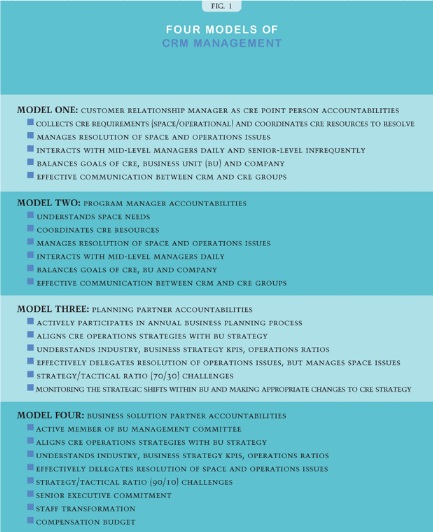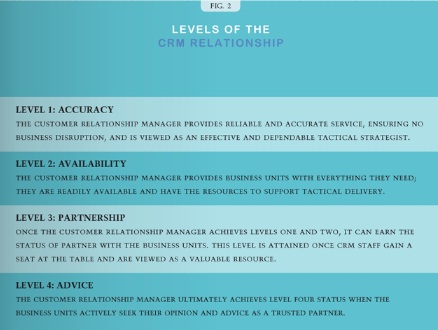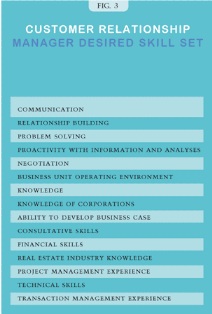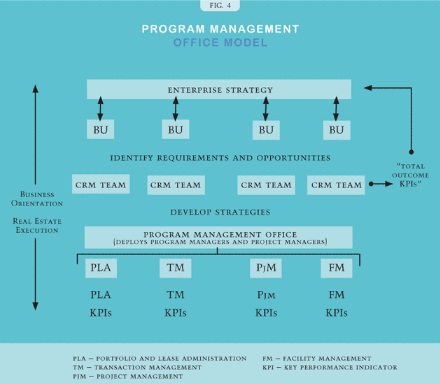Corporate real estate (CRE) organizations are increasingly implementing Customer Relationship Management (CRM) programs into their organizational models to ensure alignment between the strategic direction of their company and the business decisions being made by the corporate real estate group. However, the models, tools and techniques used to support this evolving function vary, resulting in a range of CRM programs — from tactical to strategic — and a wide array of results.
The Evolution of CRM
We have identified four models of CRM alignment, which CRE organizations typically adopt (see Figure 1). The first CRM model represents a tactical role, with the Customer Relationship Manager serving primarily as a point person for the real estate organization, charged with collecting CRE requirements and managing the resolution of space requests and service delivery issues. The Model One CRM team interacts primarily with mid-level managers, rarely interfacing with senior-level executives.
In the second model, CRM staff performs a Program Manager role, offering a greater understanding of demand forecasting. This role oversees the delivery of real estate services, yet still has similar qualities as the Model One Customer Relationship Manager, serving as the point person for mid-level managers and coordinating resources.
In Models Three and Four, the CRM role evolves from tactical to strategic by dedicating a greater percentage of their time to gaining business knowledge, building relationships and developing proactive solutions at the highest level of their assigned businesses.
The Model Four Customer Relationship Manager has a stake in the decision-making process and serves as a business planning partner to the customer and the CRE organization. The Model Four Customer Relationship Manager understands industry and business strategy performance metrics and effectively delegates resolution of space and operational issues, in addition to performing one or more of the aforementioned roles. The strategic focus of Model Four’s role elevates the CRE organization to that of an active advisor and collaborative consultant to the business units.
In a recent pulse survey of 20 CRE executives conducted by CB Richard Ellis (CBRE), most corporate real estate directors indicated that they consider their CRM programs to fall into either Model One or Two on the continuum. Only a handful of respondents regard their CRM programs as having evolved to Model Three. No CRE director viewed their CRMs to be in Model Four status, with the group agreeing that Model Four may not be the ultimate goal for all CRE organizations.
But how does corporate real estate get to a Model Four CRM program? We take a look at some of the challenges corporate real estate organizations face as well as the elements of an effective CRM program to reveal how companies can evolve from Model One to Model Four.
Challenges with Current CRM Models
Managing disconnect between CRE and business unit goals. One key finding in our research is that all too often, CREs develop their CRM programs — determining roles and responsibilities as well as desired characteristics of the Customer Relationship Manager — without consulting with the business units. Ironically, the Customer Relationship Manager’s role is to ensure the customer’s strategy and goals are effectively conveyed to the real estate organization and executed upon. So why wouldn’t the customer be a part of the CRM program development process? This lack of involvement can cause a misalignment between the goals and strategies of the business units and the overall delivery of real estate services.
As with any key initiative, gaining input and insight from key stakeholders is a major success factor in the development of the CRM role. It is critical that the CRE department understands what level of relationship the business units expect from the CRM role. CRE departments and business units can consider the four relationship levels identified in Figure 2.
Customer Relationship Managers can create trust by illustrating an ability to understand the operating objectives of clients, developing strategies that help improve operating efficiency, and following through with flawless execution and communication. Only once this trust is built can “partnership” and “advice” follow, helping to evolve the Customer Relationship Manager into the Model Three and Four levels.
Overcoming misalignment of roles and talent. Through interviews and discussions with senior CRE executives, CBRE has discovered that many feel their CRM programs and individual Customer Relationship Managers lack the core capabilities required for this function. Figure 3 illustrates the optimal characteristics of a Customer Relationship Manager, based on our recent pulse survey. Corporate real estate directors ranked 14 CRM skill sets in order of their importance. Traditionally valued corporate real estate skill sets, such as transaction management, project management and financial analysis ranked lowest, while softer skill sets, such as communication and relationship building ranked highest. This suggests that the tide is turning when it comes to considering skill sets for the CRM role — the strategic, more valuable Customer Relationship Manager might not necessarily be the one with the real estate experience, but more so, the strong communication skills.
We’ve observed that Customer Relationship Managers who focus on strategy share strong relationship management and communication skills. Real estate professionals with these skill sets can often navigate amongst various stakeholders, opening lines of communication and resolving tensions that can occur from a siloed structure.
But moving a staff member with predominantly tactical skills into the role of strategic relationship manager, without investing in the development of communication and relationship building skill sets, usually does not produce an effective Model Four, strategic Customer Relationship Manager. To achieve an effective Model Three or Four CRM program, we recommend that companies evaluate their hiring process. Our client experience has shown that some of the most successful Customer Relationship Managers come from the business units themselves and often lack a background in corporate real estate. It is important to engage business unit executives during the hiring process to ensure that the desired CRM skill sets are sought after and met. This will set the relationship foundation required for the Customer Relationship Managers’ future alignment with the business units.
Maintaining strategic focus. Customer Relationship Managers in Models One or Two on the spectrum often focus on a tactical approach to real estate services. In order for the CRM program to become strategic and involved in the business planning process, the staff needs to have the ability to move away from a focus on implementation of real estate delivery. Customer Relationship Managers are only able to let go of these tactical implementation duties if they have reliable and highly skilled execution partners, either in-house or outsourced, so that the Customer Relationship Manager can focus on building a strategic partnership with the business units.
Our studies indicate that the most effective CRM team members are those that can focus on building relationships with the customer and understanding the strategy of their assigned business units. CRM success is ultimately achieved when business strategy is effectively translated into terms other CRE team members can use to develop strategic real estate plans that are aligned with the company’s core business objectives. Successful CRM programs maintain a balance between the strategic capabilities that enable participation in the executive decision-making process and the tactical savvy required to execute on those customer goals through real estate delivery.
One emerging trend in CRE organizational models is to have two separate functions: one focused on building relationships and capturing business knowledge and the other on executing the tactical requirements associated with service delivery. This organizational model enables Customer Relationship Managers to align with their real estate executives, becoming more of a business planning partner, leaving the execution to the field teams. (We discuss this alternate organizational model in the next section.) The case study below reveals how one CBRE client has successfully implemented executive level Customer Relationship Managers, who are closely aligned with their respective business units and focused on strategic planning.
Aligning with client’s growth. The CBRE client roundtable session highlighted the fact that many CRM models struggle to stay aligned with their companies’ growth due in part to mergers and acquisitions. Companies that merge and acquire multiple companies typically experience a rapid growth in real estate portfolios and people. When players change and companies change, the business unit’s focus can change, which makes it a challenge at times for corporate real estate to keep up.
Companies must stay flexible to keep pace with the changing landscape. For example, one CBRE client’s employee population doubled in the past 18 months due to three mergers. That company’s challenge is to integrate its CRM with the portfolio planning process, which varies according to asset type.
There isn’t necessarily one model or one-size-fits-all solution for corporate real estate CRM programs. Varying models work if they have certain basic elements in place, such as well-defined organizations, communication and analysis tools, a thorough and comprehensive planning process, and the skills and training to ensure that the optimal characteristics are developed and cultivated. These elements are discussed in the next section.
Elements of an Effective CRM Program
Consider the organizational model: linking CRM to business unit strategy and delivery. Research and discussions with corporate real estate leaders reveal common themes of successful CRM programs. The organizational model of CRE can play a pivotal role in the success of a CRM program. As discussed earlier, one of the challenges with CRM programs is that Customer Relationship Managers tend to be either too tactical or pulled into the tactical delivery of real estate, thereby losing focus on building the appropriate relationships necessary to understand the strategic direction of the business.
A good real estate organizational model needs to be supported by the right people, tools and communication methods to enable a Model Four CRM program. CBRE Client 2 shares their elements of a successful CRM program in the case study below.
Emphasize good communication. Communication and relationship building skills are the top two desired characteristics of CRM staff. Developing those skills — according to our survey — along with preparing a thorough communication plan are critical to the success of the CRM program.
Effective communication is bi-directional. Remember to incorporate feedback mechanisms into your communication plan geared toward your key stakeholders. Understanding their perspective will enable you to customize your existing plan to your customer’s preferences.
Use the right analytical methods. Communication is effective when supported by a variety of channels, which should be outlined in a formal plan. Strategic analysis and performance are effective when aided by the right business methods and tools. The following methods will help take Customer Relationship Managers to the next level, enabling them to become more strategic in their partnership approach, and thus, ultimately achieve the status of valued partner to the business units:
1. Analyze the Portfolio: It is of utmost importance in any real estate client relationship to understand the client portfolio. Some specific portfolio analyses that no Customer Relationship Managers should be without include: vacancy rates, lease expiration dates, utilization rates and occupancy, among others. 2. Perform Space Planning/Utilization Study: Understanding vacancy rates and space usage at each location is critical to making strategic space decisions. This knowledge will support the Customer Relationship Manager’s ability to be a business partner to the client. 3. Develop a Business Case: Like a good communication plan, building a business case is important when undertaking an initiative, such as alternative working environments or relocating a campus/facility. Having a business case tool template will ensure that executive managers cover the bases when determining budget, timing and resources needed for their project. 4. Understand Demand: Determining demand is critical to forecasting future needs. Having a consistent template questionnaire for Customer Relationship Managers to use to understand demand will enable them to make strategic decisions regarding the client portfolio. 5. Implement Effective Reporting Tools: Using effective reporting tools, such as a dashboard, enables CRE departments to consistently track and communicate updates, i.e., occupancy cost as a percentage of revenue. 6. Perform Industry or Internal Benchmarking: Benchmarking enables an organization to understand how space is typically utilized within the company’s industry, geography and/or by asset type. When proactively adapted to a real estate portfolio, benchmarking can serve as a catalyst for change, delivering significant value to the entire organization.
Put a solid process in place. The disconnect between CRE and the business units can cause CRM programs to underperform, which is why it is important to incorporate the business units into the CRM organizational development process. If the business units understand the function and role of the Customer Relationship Manager and participate in the development process, the result is an aligned organization with a focus on executing the individual goals of the business units.
Customer Relationship Managers should ask probing questions to implement the best process. For example, how can we do a better job of projecting demand? What are the revenue projections and financial ratios? How can we leverage information to deliver more accurate staffing projections? By understanding information, a process and associated tools can be put in place to support strategic alignment with customers. CBRE Client 3 has put an effective process in place that ensures alignment between the customer and the real estate organization, as is described in the case study below.
Get the right people in the right roles. As discussed earlier in this paper, the Customer Relationship Manager role is all too often filled with existing staff whose skills and competencies might not be the best fit or who have not received sufficient training. Considering the traits based on research and our survey, the optimal traits for the role are strong communication, relationship building and problem solving skills. Real estate organizations will need to rethink the way they staff these roles and work with human resources departments to ensure the appropriate skill sets are matched. Targeted questionnaires and writing tests during the screening process can help reveal the communication and relationship building ability of the prospective candidate. Seeking input from the business units is also helpful. Real estate and industry knowledge is a plus, but the ability to build relationships, listen to and effectively communicate with customers is becoming paramount to the effectiveness of the Customer Relationship Manager role.
Make sure CRM staff have the skills and are trained to do their job. Once talent is hired and onboard, real estate organizations can ensure that their Customer Relationship Managers are properly trained and have the skill sets to perform their jobs according to the desired CRM model. A thorough and comprehensive training program is critical to the success of the CRM program.
One challenge real estate organizations face in seeking these skill sets in prospective Customer Relationship Managers is that communication and relationship building qualities are sometimes considered “soft” skills by the client. These skill sets are not valued as highly as sharp strategic analysis and business negotiation capabilities. Successful Customer Relationship Managers have a balance of both “soft” communication skills and “hard” analytical business skills. Communicating the importance of the desired CRM skill set to the business units is also critical to achieving the business units’ advocacy of incorporating those skill sets into the role.
Measure your performance
Once an effective CRM program is in place, performance measurements must be designed and implemented to ensure continued success of the program. To create the appropriate performance metrics, real estate organizations need a clear understanding of the key corporate goals and the desired outcomes and behaviors of the CRM.
CRE metrics can be tailored to fit the appropriate audience as long as there is an understanding of corporate goals. For example, to increase productivity, the corporate executive will likely be most concerned about administrative cost per area, as opposed to more CRE aligned metrics such as the number of transactions per transaction manager.
The performance metrics that are employed will naturally change and evolve as the CRM program grows in maturity. A measure of success in a Model One or Two CRM program might be defined as zero surprises or false starts, where as a more mature CRM program might be measured by its ability to reduce real estate costs and ultimately achieve superior execution of strategic initiatives.
Taking CRM to the Next Level
Whether real estate organizations are evaluating the status of already established CRM programs or designing and launching a new one, it is essential to understand the overarching goals. Does the organization want its Customer Relationship Managers to be responsible for the execution of work or to be part of the strategic planning process? Garnering input from client partners is an important part of the process, so that expectations can be met and managed.
To evolve from Model One to Model Four, real estate organizations must review their own organizational models to make sure that the structure will enable achievement of desired behaviors and goals. Does the organizational model support or enable the Customer Relationship Manager to be the strategic business planning partner real estate wants it to be? Are the right skill sets sought after during the screening and hiring process to ensure the appropriate people are brought into the organization? Is there a defined communication process supported by effective analytical tools for that Customer Relationship Manager to perform the job? Is the Customer Relationship Manager supported by an effective and trusted execution team?
These questions must be addressed to take the Customer Relationship Manager role to the next level and reach the goal of becoming an effective business unit partner.
About the Authors:
Karen Ellzey is the Executive Managing Director of CBRE’s Global Client Strategies group. The team is organized to deliver tailored strategies to corporate real estate organizations through a core team of platform consultants, as well as through embedded and project-based resources located all over the world. Ellzey brings 20 years of consulting, communications and management experience to her role.
Darcy Mackay is Senior Managing Director in CBRE’s Global Client Strategies group, and leads consulting engagements in the areas of corporate strategic planning and location/site selection analysis for both private and public sector clients. She brings a broad base of knowledge to her practice through her work with corporate occupiers as well as with developers, investors and lenders. Creating alignment between business and real estate strategy forms the core of her work with corporate occupiers.
As a Consulting Associate for CBRE’s Global Corporate Services group, Julie Johnson is responsible for providing strategy to our integrated accounts. She specializes in real estate outsourcing, organizational design, customer relationship management, portfolio strategy and corporate location strategy.
Cosima Zimmerman is a Communications Director with CBRE’s Global Corporate Services group in Charlotte, North Carolina. Zimmerman is focused on targeting clients’ organizational communication needs and developing and implementing customized strategies.



